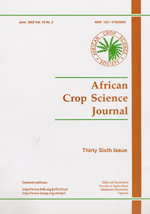
|
African Crop Science Journal
African Crop Science Society
ISSN: 1021-9730
EISSN: 1021-9730
Vol. 4, No. 1, 1996, pp. 1-9
|
 Bioline Code: cs96034
Bioline Code: cs96034
Full paper language: English
Document type: Research Article
Document available free of charge
|
|
|
African Crop Science Journal, Vol. 4, No. 1, 1996, pp. 1-9
| en |
Integrating Farmers' Information with Geographic Information Systems for Targeting of Maize Research in Kenya
Hassan, R.M. & Njoroge, K.
Abstract
Information from farmers' surveys was combined with
climatic information to evaluate the adequacy of the current
biophysical characterisation of maize (Zea mays)
adaptation zones (MAZs) in Kenya. The analysis showed that
a better definition of MAZs was achieved by integrating
farmers' information with the climatic data. Six MAZs were
defined as distinct target domains for maize research as
opposed to the previous four zones described by biophysical
characterisation alone. The major biotic and abiotic stress
factors, system constraints and socio-economic circumstances
were found to vary significantly across the six zones. These
attributes significantly influence farmers' decisions on maize
cropping pattern and intensity, planting regimes and varietal
selection, including germplasm maturity. The results indicated
that the Kenya Agricultural Research Institute (KARI) needs to
reallocate research resources to the transitional and
mid-altitude zones and to reverse the historical bias towards
the high tropics if larger gains are to be realised from maize
research.
Keywords
Adaptation zones, farmers' knowledge, maize germplasm, GIS
|
| |
| fr |
Hassan, R.M. & Njoroge, K.
Résumé
L'information en provenance des enquetes aupres des
paysans etait combinee avec l'information climatique afin
d'evaluer avec exactitude les caracteristiques biophysiques
courantes des zones d'adaptation de mays (MAZs) du Kenya.
L'analyse a montre que la meilleure definition de MAZs etait
accomplie par l'integration de l'information des paysans et
des donnees climatiques. La bonne caracterisation des systemes
de production du mays ainsi que des contraintes est primodiale
pour cibler la technologie du mays. Six MAZs [etaient definies
comme des domaines a buts differents pour la recherche sur le
mays contrairement aux 4 zones anterieures decrites seulement
par la caracterisation biophysique. Les principaux facteurs de
stress biotique et abiotique, le systeme des contraintes et
les circonstances socio-economiques variaient
significativement a travers les 6 zones. Ces facteurs
influencent significativement les decisions des paysans sur
l'intensite et le mode de culture du mays, les regimes de
plantation et la selection varietale y compris la maturite du
germoplasme. Les resultats ont indique que l'Institut de
Recherche Agronomique du Kenya (KARI) a besoin de reaffecter
les ressources de recherche dans les zones de transition et de
moyenne altitude et d'inverser la tendance historique vers les
hautes terres de tropiques si on veut realiser une plus grande
production de graines de mai's a partir de la recherche.
Mots Clés
Zones d'adaptation, connaissances des agriculteurs, germoplasme du mais, GIS
|
| |
© Copyright 1996 - African Crop Science Society
|
|
